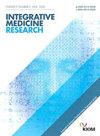Evaluating efficacy and safety of auricular acupressure in treating allergic rhinitis: A randomized controlled trial
IF 3
4区 医学
Q2 INTEGRATIVE & COMPLEMENTARY MEDICINE
引用次数: 0
Abstract
Background
Allergic rhinitis significantly impacts health and quality of life, and symptom management remains a considerable challenge. This study aims to compare the treatment efficacy of auricular acupressure combined with fluticasone propionate versus fluticasone propionate alone for allergic rhinitis.
Methods
A randomized, double-blind, controlled clinical trial study was conducted with 90 patients diagnosed with allergic rhinitis according to ARIA 2008 guidelines. The control group (n = 45) received standard treatment, including fluticasone propionate, and sham auricular acupressure (SA), performed four times over four weeks. The intervention group (n = 45) received standard treatment with actual auricular acupressure (AA), performed four times over four weeks. Treatment efficacy was evaluated using a 100-mm visual analog scale (VAS) weekly and after four weeks of treatment, along with monitoring for adverse effects of auricular acupressure.
Results
After four weeks, the reduction in VAS scores for individual symptoms, including sneezing, runny nose, blocked nose, and itchy nose, showed mean differences between the control and intervention groups of 17.71 (95 % CI, 10.60–24.82); 22.73 (95 % CI, 15.71–29.76); 22.33 (95 % CI, 15.30–29.37); and 21.29 (95 % CI, 14.27–28.31) points, respectively (p < 0.0001). The RQLQ score, medication usage decreased significantly more in the intervention group than in the control group. Adverse effects were reported in 11.11 % of cases, mostly mild, transient, and not requiring additional treatment.
Conclusions
Auricular acupressure combined with fluticasone propionate provides effective and safe treatment for allergic rhinitis patients. Further interventional studies based on the classification of clinical syndromes in traditional medicine are warranted.
Trial registration: ClinicalTrials.gov, NCT06323304.
评价耳穴按压治疗变应性鼻炎的疗效和安全性:一项随机对照试验
背景变应性鼻炎显著影响健康和生活质量,症状管理仍然是一个相当大的挑战。本研究旨在比较耳穴压联合丙酸氟替卡松与单用丙酸氟替卡松治疗变应性鼻炎的疗效。方法采用随机、双盲、对照临床试验方法,对90例根据ARIA 2008指南诊断为变应性鼻炎的患者进行研究。对照组(n = 45)给予标准治疗,包括丙酸氟替卡松和假耳穴按压(SA), 4周内进行4次。干预组(n = 45)给予标准的实际耳穴按压(AA)治疗,4周内进行4次。采用100毫米视觉模拟量表(VAS)每周和治疗4周后评估治疗效果,同时监测耳穴按压的不良反应。结果4周后,对照组和干预组在打喷嚏、流鼻涕、鼻塞和鼻痒等症状的VAS评分下降,平均差异为17.71 (95% CI, 10.60-24.82);22.73 (95% ci, 15.71 ~ 29.76);22.33 (95% ci, 15.30-29.37);和21.29 (95% CI, 14.27-28.31)点(p <;0.0001)。干预组RQLQ评分、用药情况下降明显高于对照组。11.11%的病例报告了不良反应,大多是轻微的,短暂的,不需要额外的治疗。结论穴位按压联合丙酸氟替卡松治疗变应性鼻炎安全有效。基于中医临床证候分类的进一步介入研究是有必要的。试验注册:ClinicalTrials.gov, NCT06323304。
本文章由计算机程序翻译,如有差异,请以英文原文为准。
求助全文
约1分钟内获得全文
求助全文
来源期刊

Integrative Medicine Research
Medicine-Complementary and Alternative Medicine
CiteScore
6.50
自引率
2.90%
发文量
65
审稿时长
12 weeks
期刊介绍:
Integrative Medicine Research (IMR) is a quarterly, peer-reviewed journal focused on scientific research for integrative medicine including traditional medicine (emphasis on acupuncture and herbal medicine), complementary and alternative medicine, and systems medicine. The journal includes papers on basic research, clinical research, methodology, theory, computational analysis and modelling, topical reviews, medical history, education and policy based on physiology, pathology, diagnosis and the systems approach in the field of integrative medicine.
 求助内容:
求助内容: 应助结果提醒方式:
应助结果提醒方式:


